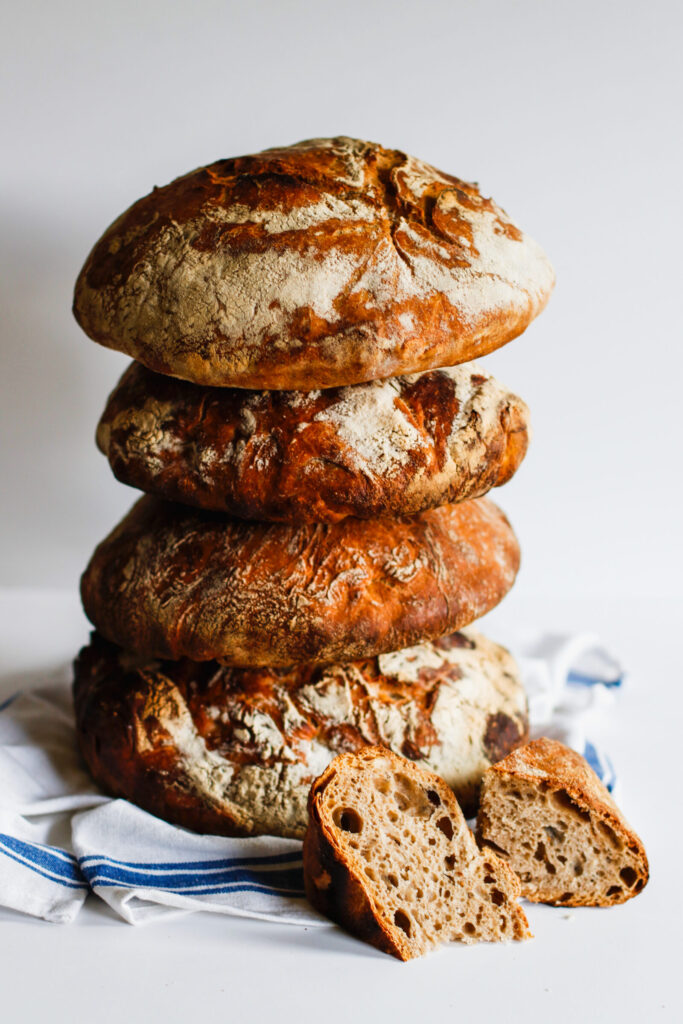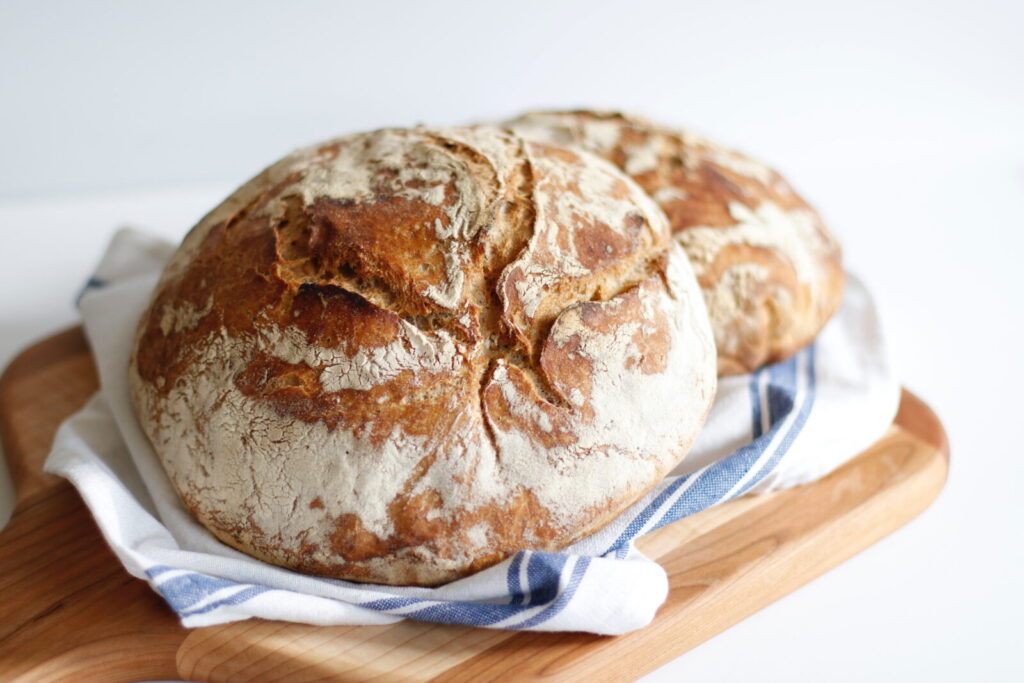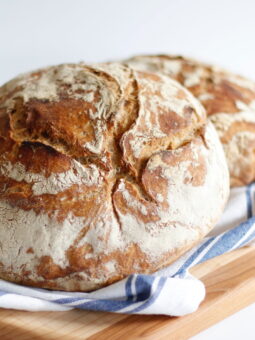No-knead Artisan Bread
Bake-up your very own no-knead artisan bread! Crusty on the outside and soft on the inside, this super simple recipe doesn’t require a starter or anything fancy.
Don’t forget to try out my roasted garlic and rosemary dutch oven bread or this homemade whole grain bread recipe too!

Why you’ll love this no-knead artisan bread
- A good beginner bread: This recipe requires minimal effort and no kneading, making it a great option for beginner bakers or those short on time.
- Delicious: The long fermentation time and simple ingredients allow the flavors to develop, resulting in a flavorful and satisfying loaf.
- Artisan-style: The rustic appearance and chewy texture of this bread are reminiscent of bread you might find in a bakery or restaurant.
- Affordable: With just a few simple ingredients, this bread is a budget-friendly option for those looking to save money on groceries.
- Healthy: This bread contains no preservatives or artificial ingredients, and the use of whole wheat or spelt flour can increase its nutritional value.
- Impress guests and family: This bread is sure to impress guests with its beautiful appearance and homemade taste. It’s a great addition to any meal or gathering.
Ingredients and substitution notes
- Whole wheat flour can be substituted for up to half of the all-purpose flour in this recipe. Using more than half may result in a denser loaf.
- Spelt flour can be substituted for the all-purpose flour, but note that the bread may have a slightly different texture and flavor.
- If you prefer a saltier bread, you can increase the salt to 1 1/2 tsp.
- You can use room temperature water instead of cold water, but the rise time may be shorter.
- You can also experiment with adding herbs, spices, or other flavorings to the dough before baking.

No-knead Artisan Bread Recipe variations and add-ins
- Garlic and herb: Mix in 1-2 cloves of minced garlic and 1-2 tablespoons of chopped fresh herbs such as rosemary, thyme, or oregano into the dough before baking.
- Everything bagel bread: Mix in everything bagel seasoning (a blend of sesame seeds, poppy seeds, garlic, onion, and salt) into the dough before baking. You can also sprinkle some on top of the bread before baking for extra flavor.
- Nut and seed bread: Mix in a variety of chopped nuts and seeds (such as walnuts, pecans, sunflower seeds, or pumpkin seeds) into the dough before baking.
- Sweet bread: Mix in sweet ingredients like dried fruit (such as raisins, cranberries, or chopped dates), nuts (such as pecans or almonds), and spices (such as cinnamon or cardamom) into the dough before baking. You can also sprinkle some sugar on top of the bread before baking for a sweet crust.

Top tips
- Spelt flour has a mild delicious flavor, but does not have as much gluten, and therefore makes the loaf a little flatter. If you want the round tall loaf, use whole wheat flour instead. I really like the One Degree sprouted flour. It is organic, non-GMO, and sprouted.
- If you have never tried artisan bread like this before, you may want to start with a ratio of 2:1 (2 cups all-purpose flour & 1 cup whole grain flour.) This will ensure a lighter bread. You can also make this 100% whole grain, when I do, I usually add an additional 1/4 tsp of yeast.
- Use a scale: Weighing your ingredients instead of measuring by volume can ensure consistency in your bread-making process.
- Use a Dutch oven: A Dutch oven helps create a steamy environment inside the oven, which is crucial for creating a crusty and chewy crust on your bread.
- Be patient: Let the dough rise for at least 12 hours or overnight. The long fermentation time allows the flavors to develop and creates a chewy texture.
- Use cold water: Using cold water can slow down the fermentation process, resulting in a better flavor and texture in your bread.
- Experiment with flour types: Mix in different types of flour such as whole wheat, spelt, rye, or bread flour to create different textures and flavors in your bread.
- Preheat your Dutch oven: Place your Dutch oven in the oven while it preheats to ensure it’s hot when you add the dough. This will help create a nice crust on you no-knead artisan bread.
- Let the bread cool completely: Resist the temptation to cut into the bread when it’s still warm. Letting it cool completely will help it set and allow the flavors to fully develop.
- Practice makes perfect: Making no-knead artisan bread takes practice, so don’t be discouraged if your first few loaves don’t turn out perfectly. Keep experimenting and adjusting until you find a recipe and technique that works best for you.

Make ahead of instructions and storage
If you want to keep the bread fresh for longer, you can freeze it. Slice the bread and place it in a resealable plastic bag or airtight container. Freeze for up to 3 months.
To thaw frozen bread, remove it from the freezer and let it come to room temperature. Reheat in the oven at 350°F for 5-10 minutes, or until warm and crispy. You can also pop slices in the toaster.
FAQs
Do I need a Dutch oven to make no-knead artisan bread?
A Dutch oven is recommended for making no-knead artisan bread because it helps create a steamy environment inside the oven, which is crucial for creating a crusty and chewy crust on your bread.
However, you can also use a baking stone or a cast-iron skillet as an alternative.
Wrapping it up
Enjoy whipping up your very own beautiful loaf of bread. A homemade loaf of bread makes the loveliest gift or addition to a special meal.
If you love homemade breads then try my vegan banana bread or this homemade cornbread.

Artisan Bread (No-Knead)
Description
Bake-up your very own no-knead artisan bread! Crusty on the outside and soft on the inside, this super simple recipe doesn’t require a starter or anything fancy.
Ingredients
- 1 1/2 cups all-purpose flour
- 1 1/2 cups whole wheat or spelt flour (see note)
- 1/4 teaspoon yeast
- 1 1/4 teaspoons salt
- 1 1/2 cups cold water
Instructions
- In a medium size bowl mix together all the dry ingredients (flours, yeast, and salt).
- Add the water and mix just until combined. The mixture should look pretty loose. Cover with a towel and let sit overnight (12 hours).
- On a generously floured baking silicon mat, pour out the bread dough and slightly flour the top of the bread. Pull each side towards the middle to make a ball, then turn over, and let it rest for 1-2 hours.
- 30 minutes before ready to bake the bread, preheat the oven to 480 F with the Dutch oven and lid (make sure the lid is not plastic and can withstand 500 F).
- Then carefully take the Dutch oven out of the oven, remove the lid, place the bread dough in the Dutch oven, seam side up (this makes that cracked beautiful crust). Replace the lid and place back into the oven.
- Set timer for 30 min. Then remove the lid, leave the bread in the oven for 10-15 more minutes, this will add a nice color to the crust while the bread finishes baking. Remove from oven. Carefully, remove the bread from the dutch oven and cool on a cooling rack.
Notes
- Spelt flour has a mild delicious flavor, but does not have as much gluten, and therefore makes the loaf a little flatter. If you want the round tall loaf, use whole wheat flour instead.
- I really like the One Degree sprouted flour. It is organic, non-GMO, and sprouted. Click Here to visit their website
- If you have never tried artisan bread like this before, you may want to start with a ratio of 2:1 (2 cups all purpose flour & 1 cup whole grain flour.) This will ensure a lighter bread. You can also make this 100% whole grain, when I do, I usually add an additional 1/4 tsp of yeast.

Hi! Do you do anything with the Dutch oven???? Before you put your dough in it…. Like spray some oil in there, water? I know in the video, you took the lid off and a bunch of steam came out…. just wondering…. thanks! (btw this Looks soooooo good!)
Hi Stefanie! Yes, we season the dutch oven by brushing it with a little olive oil every so often.
I made this today…. super good! We bought a cast iron Dutch oven, like the one you had in the video. Lol! I would definitely recommend this recipe, it’s delicious! (I made potato soup to go with it.) thanks Ani!
I am so happy to hear that you enjoyed the bread, Stefanie! Potato soup sounds amazing! Thank you for your sweet comment. ?
Can I use home ground flour and do not have a Dutch oven. Will anything else work?
You can definitely use home ground flour, although you may need to adjust the liquid slightly. In order to get the same effect without a dutch oven, you can bake the bread in a bread pan, and put an additional pan with hot water in the oven as you bake it, creating the same effect as the dutch oven.
Place the pan (for the water) in the oven as the oven heats up, but do not put the water in until after you have put in the bread dough in the oven. Be careful not to let out too much heat as you do this, you want the oven to stay very hot. Add 1 1/2 cups of very hot water to the water pan (not the bread pan) as soon as the bread is in the oven. This will create the steam that makes the wonderful crust. Be careful not to burn yourself as the steam will immediately start, close the oven door as soon as possible.
Hope this works for you, we have done this method in the past. The steam is crucial. You are creating a moist hot environment. Thank you for your support! ?
I am excited to prepare and bake this bread. Off to the store for my first dutch oven. No eggs! Wonderful!
Fantastic! I hope you enjoy the recipe!
Pingback: Chef Ani - Phenomenal Homemade Whole Grain Bread
I just made this. It was so easy, and it turned out beautifully! Thank you!
I got to see the picture. You did a beautiful job. This is a favorite bread in my family. Thank you for trying my recipes.